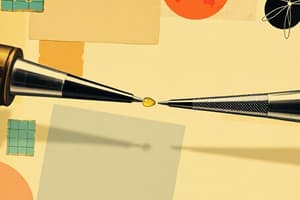Podcast
Questions and Answers
How much does a typical micropipette cost?
How much does a typical micropipette cost?
About $200
Why is it important to use proper technique when handling a micropipette?
Why is it important to use proper technique when handling a micropipette?
To ensure it works for a long time without any repairs.
What can happen if a micropipette is handled improperly?
What can happen if a micropipette is handled improperly?
It can easily break.
What are micropipettes primarily used for?
What are micropipettes primarily used for?
What category of item do micropipette tips belong to?
What category of item do micropipette tips belong to?
Which of these categories is NOT part of the taxonomic hierarchy?
Which of these categories is NOT part of the taxonomic hierarchy?
Who is considered the Father of Taxonomy?
Who is considered the Father of Taxonomy?
The genus name in the binomial nomenclature is always written in lowercase.
The genus name in the binomial nomenclature is always written in lowercase.
Classification is the grouping of objects based on ______.
Classification is the grouping of objects based on ______.
Match the following categories of classification with their descriptions:
Match the following categories of classification with their descriptions:
What is the scientific binomial for a wise man?
What is the scientific binomial for a wise man?
Study Notes
Micropipette Handling
- A micropipette is a precision instrument that is expensive, costing around $200 each.
- It is easily broken and requires good technique to prolong its lifespan without needing repairs.
- Proper technique is crucial to ensure long use without the need for costly repairs.
Overview of Taxonomy
- Taxonomy is the science of naming, describing, and classifying all living organisms, including plants.
- Classification relies on behavioral, genetic, and biochemical differences among organisms.
- Key processes include characterization, identification, and classification.
Taxonomic Categories
- Organisms are organized into hierarchical categories: kingdom, phylum, class, order, family, genus, and species.
Carolus Linnaeus
- Known as the Father of Taxonomy, Linnaeus created systematic methods for naming and organizing species.
- Developed a hierarchical classification framework that remains in use, arranging life into kingdoms, classes, orders, genera, and species.
Taxonomic Hierarchy
- The taxonomic hierarchy can be visualized as a pyramid with seven levels:
- Kingdom
- Phylum
- Class
- Order
- Family
- Genus
- Species
The Binomial Nomenclature System
- A species is identified by its combination of specific (species) and generic (genus) names, forming a binomial name.
- Names are italicized or underlined, with the genus capitalized and the species in lowercase.
- For example, the scientific name for humans is represented as Homo sapiens or Homo sapiens.
Definition of Classification
- Classification involves grouping objects based on shared characteristics.
- In scientific contexts, biology and chemistry are categorized as branches of science, demonstrating classification.
Classification of Animals
- Animals are divided into two main groups:
- Vertebrates (with backbone)
- Includes birds, mammals, and amphibians.
- Can be warm-blooded or cold-blooded.
- Invertebrates (without backbone)
- Encompasses a variety of phyla including Porifera, Cnidaria, Annelida, Mollusca, and Arthropoda.
- Vertebrates (with backbone)
Notable Invertebrate Phyla
- Porifera: Sponges, simple aquatic animals.
- Cnidaria: Jellyfish, corals, and sea anemones.
- Annelida: Segmented worms such as earthworms and leeches.
- Mollusca: Includes snails, octopuses, and clams.
- Arthropoda: Largest phylum, includes insects and crustaceans.
Studying That Suits You
Use AI to generate personalized quizzes and flashcards to suit your learning preferences.
Description
Learn the proper techniques for handling micropipettes, a precision instrument that requires good handling to prolong its lifespan and avoid costly repairs. Improve your laboratory skills with this essential knowledge.




